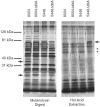Inactivation of DltA modulates virulence factor expression in Streptococcus pyogenes
- PMID: 19401780
- PMCID: PMC2671602
- DOI: 10.1371/journal.pone.0005366
Inactivation of DltA modulates virulence factor expression in Streptococcus pyogenes
Abstract
Background: D-alanylated lipoteichoic acid is a virtually ubiquitous component of gram-positive cell walls. Mutations in the dltABCD operon of numerous species exhibit pleiotropic effects, including reduced virulence, which has been attributed to increased binding of cationic antimicrobial peptides to the more negatively charged cell surface. In this study, we have further investigated the effects that mutating dltA has on virulence factor expression in Streptococcus pyogenes.
Methodology/principal findings: Isogenic Delta dltA mutants had previously been created in two distinct M1T1 isolates of S. pyogenes. Immunoblots, flow cytometry, and immunofluorescence were used to quantitate M protein levels in these strains, as well as to assess their ability to bind complement. Bacteria were tested for their ability to interact with human PMN and to grow in whole human blood. Message levels for emm, sic, and various regulatory elements were assessed by quantitative RT-PCR. Cell walls of Delta dltA mutants contained much less M protein than cell walls of parent strains and this correlated with reduced levels of emm transcripts, increased deposition of complement, increased association of bacteria with polymorphonuclear leukocytes, and reduced bacterial growth in whole human blood. Transcription of at least one other gene of the mga regulon, sic, which encodes a protein that inactivates antimicrobial peptides, was also dramatically reduced in Delta dltA mutants. Concomitantly, ccpA and rofA were unaffected, while rgg and arcA were up-regulated.
Conclusions/significance: This study has identified a novel mechanism for the reduced virulence of dltA mutants of Streptococcus pyogenes in which gene regulatory networks somehow sense and respond to the loss of DltA and lack of D-alanine esterification of lipoteichoic acid. The mechanism remains to be determined, but the data indicate that the status of D-alanine-lipoteichoic acid can significantly influence the expression of at least some streptococcal virulence factors and provide further impetus to targeting the dlt operon of gram-positive pathogens in the search for novel antimicrobial compounds.
Conflict of interest statement
Figures







Similar articles
-
A functional dlt operon, encoding proteins required for incorporation of d-alanine in teichoic acids in gram-positive bacteria, confers resistance to cationic antimicrobial peptides in Streptococcus pneumoniae.J Bacteriol. 2006 Aug;188(16):5797-805. doi: 10.1128/JB.00336-06. J Bacteriol. 2006. PMID: 16885447 Free PMC article.
-
Relationship between expression of the family of M proteins and lipoteichoic acid to hydrophobicity and biofilm formation in Streptococcus pyogenes.PLoS One. 2009;4(1):e4166. doi: 10.1371/journal.pone.0004166. Epub 2009 Jan 9. PLoS One. 2009. PMID: 19132104 Free PMC article.
-
Role of Streptococcus pyogenes two-component response regulators in the temporal control of Mga and the Mga-regulated virulence gene emm.Infect Immun. 2004 Jun;72(6):3668-73. doi: 10.1128/IAI.72.6.3668-3673.2004. Infect Immun. 2004. PMID: 15155682 Free PMC article.
-
Virulence factor regulation and regulatory networks in Streptococcus pyogenes and their impact on pathogen-host interactions.Trends Microbiol. 2003 May;11(5):224-32. doi: 10.1016/s0966-842x(03)00098-2. Trends Microbiol. 2003. PMID: 12781526 Review.
-
Variation, Indispensability, and Masking in the M protein.Trends Microbiol. 2018 Feb;26(2):132-144. doi: 10.1016/j.tim.2017.08.002. Epub 2017 Aug 31. Trends Microbiol. 2018. PMID: 28867148 Free PMC article. Review.
Cited by
-
Impact of Citral and Phloretin, Alone and in Combination, on Major Virulence Traits of Streptococcus pyogenes.Molecules. 2019 Nov 21;24(23):4237. doi: 10.3390/molecules24234237. Molecules. 2019. PMID: 31766432 Free PMC article.
-
Lactobacilli reduce cell cytotoxicity caused by Streptococcus pyogenes by producing lactic acid that degrades the toxic component lipoteichoic acid.Antimicrob Agents Chemother. 2011 Apr;55(4):1622-8. doi: 10.1128/AAC.00770-10. Epub 2011 Jan 18. Antimicrob Agents Chemother. 2011. PMID: 21245448 Free PMC article.
-
D-Serine Can Modify the Wall Teichoic Acid of MRSA via the dlt Pathway.Int J Mol Sci. 2025 Apr 25;26(9):4110. doi: 10.3390/ijms26094110. Int J Mol Sci. 2025. PMID: 40362350 Free PMC article.
-
Antimicrobial Peptide Resistance Mechanisms of Gram-Positive Bacteria.Antibiotics (Basel). 2014 Oct 13;3(4):461-92. doi: 10.3390/antibiotics3040461. Antibiotics (Basel). 2014. PMID: 25419466 Free PMC article.
-
The Transcriptional Regulator CpsY Is Important for Innate Immune Evasion in Streptococcus pyogenes.Infect Immun. 2017 Feb 23;85(3):e00925-16. doi: 10.1128/IAI.00925-16. Print 2017 Mar. Infect Immun. 2017. PMID: 27993974 Free PMC article.
References
-
- Perego M, Glaser P, Minutello A, Strauch MA, Leopold K, et al. Incorporation of D-alanine into lipoteichoic acid and wall teichoic acid in Bacillus subtilis. Identification of genes and regulation. J Biol Chem. 1995;270:15598–15606. - PubMed
-
- Peschel A, Otto M, Jack RW, Kalbacher H, Jung G, et al. Inactivaton of the dlt operon in Staphylococcus aureus confers sensitivity to defensins, protegrins, and other antimicrobial peptides. J Biol Chem. 1999;274:8405–8410. - PubMed
-
- Archibald AR, Baddiley J, Heptinstall S. The alanine ester content and magnesium binding capacity of walls of Staphylococcus aureus H grown at different pH values. Biochim Biophys Acta. 1973;291:629–634. - PubMed
Publication types
MeSH terms
Substances
Grants and funding
LinkOut - more resources
Full Text Sources
Other Literature Sources
Molecular Biology Databases

